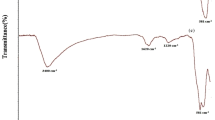Abstract
Nowadays, few-layer graphene (FLG) has been introduced as a new type of adsorbent. In this research, the orange dyes including, methyl orange (MO) as an industrial dye and the soft drink orange dye (orange Fanta soda) as a food dye, have been removed by FLG adsorbent. In all steps, UV-Vis spectroscopy as a valuable and fast method has been applied. The optical absorption coefficient has been decreased from 0.9 to less than 0.2 by FLG adsorbent for 50 ppm MO dye solution. Therefore, the MO solution with 50 ppm concentration converts to about 10 ppm output solution using 0.05 g of FLG adsorbent in a few minutes. It is about 80% adsorption dye removal efficiency. Also, MO dye removals have been performed in the range of 10 ppm to 500 ppm concentrations, but as the concentration of the solution increases, the dye adsorption ability of FLG decreases. The maximum efficient and optimum MO dye concentrations are about 100 ppm and 50 ppm, respectively, due to 0.05 g FLG adsorbent. It has been completely saturated at about 500 ppm concentration MO dye solution. Also, it has been observed that, for 50 ppm MO dye solution, increasing the amount of mass adsorbent from 0.05 to 0.25 g can cause the output MO concentration to decrease from 10 ppm to 3 ppm. It has been revealed that about 94% of MO dye can remove by 0.25 g FLG adsorbent. The contact time due to 94% MO removal process is less than 5 minutes. Therefore, only by 0.25 g of FLG adsorbent we can purify wastewater containing 50 ppm MO dye to less than 3 ppm dye concentration, at less than a few minutes. Finally, the FLG glass tube filter can remove more than 90% food orange dye in less than 90 s for 50 mL of soft drink solution. Therefore, the FLG tube filtration process is so fast, easy, and high efficient.








Similar content being viewed by others
REFERENCES
K. S. Novoselov, V. I. Fal’ko, L. Colombo, P. R. Gellert, M. G. Schwab, and K. Kim, Nature (London, U.K.) 490 (7419), 192 (2012). https://doi.org/10.1038/nature11458
B. Y. Z. Hiew et al., Process Safety Environ. Prot. 116, 262 (2018). https://doi.org/10.1016/j.psep.2018.02.010
T. H. Tu, P. T. N. Cam, L. V. T. Huy, M. T. Phong, H. M. Nam, and N. H. Hieu, Mater. Lett. 238, 134 (2019). https://doi.org/10.1016/j.matlet.2018.11.164
A. Mittal, J. Mittal, A. Malviya, and V. K. Gupta, J. Colloid Interface Sci. 340, 16 (2009). https://doi.org/10.1016/j.jcis.2009.08.019
D. Robati et al., Chem. Eng. J. 284, 687 (2016). https://doi.org/10.1016/j.cej.2015.08.131
W. **n, D. Zhu, G. Liu, Y. Hua, and W. Zhou, Int. J. Photoenergy 2012 (2012). https://doi.org/10.1155/2012/767905
L. K. de Assis, B. S. Damasceno, M. N. Carvalho, E. H. C. Oliveira, and M. G. Ghislandi, Environ. Technol. 41, 2360 (2020). https://doi.org/10.1080/09593330.2019.1567603
F. A. Arias et al., Nanomaterials 10 (4) (2020). https://doi.org/10.3390/nano10040681
S. Rani, M. Aggarwal, M. Kumar, S. Sharma, and D. Kumar, Water Sci. 30, 51 (2016). https://doi.org/10.1016/j.wsj.2016.04.001
Y. Shaet al., Chemosphere 144, 1530 (2016). https://doi.org/10.1016/j.chemosphere.2015.10.040
M. K. Uddin and U. Baig, J. Clean. Prod. 211, 1141 (2019). https://doi.org/10.1016/j.jclepro.2018.11.232
J. Xu, H. Lv, S. T. Yang, and J. Luo, Rev. Inorg. Chem. 33, 139 (2013). https://doi.org/10.1515/revic-2013-0007
R. Dubey, J. Bajpai, and A. K. Bajpai, J. Water Process Eng. 5, 83 (2015). https://doi.org/10.1016/j.jwpe.2015.01.004
C. Bulin, Y. Zhang, B. Li, and B. Zhang, J. Phys. Chem. Solids 144, 109483 (2020). https://doi.org/10.1016/j.jpcs.2020.109483
C. Xu, A. Cui, Y. Xu, and X. Fu, Carbon 62, 465 (2013). https://doi.org/10.1016/j.carbon.2013.06.035
I. Ali, O. M. L. Alharbi, A. Tkachev, E. Galunin, A. Burakov, and V. A. Grachev, Environ. Sci. Pollut. Res. 25, 7315 (2018). https://doi.org/10.1007/s11356-018-1315-9
V. Poornima Parvathi, M. Umadevi, and R. Bhaviya Raj, J. Environ. Manage. 162, 299 (2015). https://doi.org/10.1016/j.jenvman.2015.07.055
X. Genget al., Sci. Rep. 3, 1 (2013). https://doi.org/10.1038/srep01134
G. M. Morales et al., Carbon 49, 2809 (2011). https://doi.org/10.1016/j.carbon.2011.03.008
X. Geng et al., Sci. Rep. 3, 1134 (2013). https://doi.org/10.1038/srep01134
S. Gayathri, P. Jayabal, M. Kottaisamy, and V. Ramakrishnan, AIP Adv. 4 (2) (2014). https://doi.org/10.1063/1.4866595
S. K. Sahoo, A. K. Behera, R. Chandran, and A. Mallik, J. Appl. Electrochem. 50, 673 (2020). https://doi.org/10.1007/s10800-020-01422-3
Y. Subba Reddy, C. Maria Magdalane, K. Kaviyarasu, G. T. Mola, J. Kennedy, and M. Maaza, J. Phys. Chem. Solids 123, 43 (2018). https://doi.org/10.1016/j.jpcs.2018.07.009
A. Caglar, D. Düzenli, I. Onal, I. Tezsevin, O. Sahin, and H. Kivrak, J. Phys. Chem. Solids 150, 109684 (2021). https://doi.org/10.1016/j.jpcs.2020.109684
X. Liu et al., Food Addit. Contam., Part A 28, 1315 (2011). https://doi.org/10.1080/19440049.2011.604795
A. Gürses, M. Açıkyıldız, K. Güneş, and M. S. Gürses, in Dye and Pigments (Springer, Berlin, 2016), p. 31.
Z. Youssef et al., Dye Pigment 159, 49 (2018). https://doi.org/10.1016/j.dyepig.2018.06.002
A. A. A. A. A. Darwish, M. Rashad, and H. A. AL-Aoh, Dye Pigment 160, 563 (2019). https://doi.org/10.1016/j.dyepig.2018.08.045
Y. S. Al-Degs, Food Chem. 117, 485 (2009). https://doi.org/10.1016/j.foodchem.2009.04.097
Y. Hao et al., Small 6, 195 (2010). https://doi.org/10.1002/smll.200901173
A. C. Ferrari, Solid State Commun. 143, 47 (2007). https://doi.org/10.1016/j.ssc.2007.03.052
A. C. Ferrari and J. Robertson, Philos. Trans. A 362 (1824), 2477 (2004). https://doi.org/10.1098/rsta.2004.1452
H. Motahari, S. M. Bellah, and R. Malekfar, Appl. Phys. A 123, 411 (2017). https://doi.org/10.1007/s00339-017-1024-0
R. M. Hamid Motahari, Mater. Res. Express 4 (7) (2017).
Author information
Authors and Affiliations
Corresponding author
Rights and permissions
About this article
Cite this article
Motahari, H., Mohammadi, H.S. & Behjat, A. Orange Dye Removal Efficiency by Few-layer Graphene: an Investigation by UV-Vis Spectroscopy. Opt. Spectrosc. 130, 195–202 (2022). https://doi.org/10.1134/S0030400X22030092
Received:
Revised:
Accepted:
Published:
Issue Date:
DOI: https://doi.org/10.1134/S0030400X22030092




